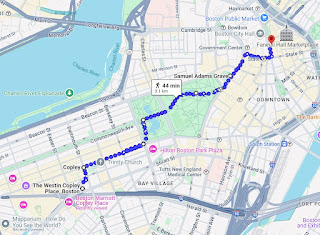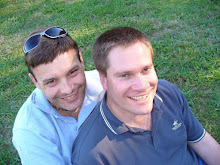Boston's oldest suburbs are filled with beautiful old buildings and history. One such building is Trinity Church, a soaring 19th-century Episcopal church on the edge of Copley Square. As luck would have it, we enjoyed a superb view of this local landmark from our hotel room. I secured our impressive view courtesy of some Starwood loyalty points I'd cashed for three nights at the Westin Copley Place. When we checked in, my gold status resulted in a complimentary room upgrade overlooking the church.
Copley Square is also home to the finish line of Boston's renowned marathon. This athletic milestone is preserved in marble along the plaza's western perimeter pavement. However, I've since learned that the finish line is actually located on a side street about a block away.
I still recall the New Zealand runner, Lorraine Moller, winning the Women's Division of the Boston Marathon in April 1984. I was an exchange student in upstate New York at the time. As a Kiwi kid living in the States, having a fellow Kiwi recognised nationally made me proud. A few months earlier, another New Zealander, Rod Dixon, had won the New York marathon.
Elsewhere in the square, we came across a delightful, but damp, sculpture depicting the Hare and Tortoise of Aesop's fable folklore. However, I preferred the equally quirky Make Way for Ducklings sculpture we encountered a few blocks away in the Boston Public Gardens. It depicts the duck family from the children’s classic of the same name. Next door in the famous Boston Common, we found more fictitious characters cast in bronze by the aptly named Frog Pond. Apparently, the pond doubles as an ice skating rink in winter.
Sunday morning dawned with partly sunny weather, making it ideal for exploring more of Boston on foot. We began the day with a visit to the Christian Science headquarters, a couple of blocks west of our hotel. It’s the home of the Mapparuim, a three-story spherical stained-glass globe room glazed with a political map of the world as it appeared in 1935.You effectively walk into a spherical room across a glass bridge suspended in mid-air and view the world as if you were standing at its core, looking outwards. It's an incredible experience! However, visitors aren't allowed to carry cameras and loose items inside. Hence, the middle image below was ripped from the internet. You can read more here.
Our next destination was North End, Boston’s original historic neighbourhood. I was thrilled to finally visit the iconic Old North Church. It’s steeple was used to warn locals of approaching British soldiers during the American Revolution. Two lanterns were hung in its distinctive white tower for less than a minute to avoid attracting the Brits' attention. We've all heard of Paul Revere, who saw this signal. He went on to ride through the night, warning nearby counties.
Boston’s revolutionary horseman is immortalised in bronze nearby. This imposing statue rests on a pink granite plinth at the end of Paul Revere Mall, a leafy pedestrian boulevard extending eastward from the church. Cyrus Dallin, a 23-year-old artist, won a competition to erect the sculpture in 1885. We later learned that he cast several versions of this statue, some of which are displayed elsewhere in the city.
Curiously, the Old North Church’s sanctuary isn’t fitted with regular rows of parallel pews. Instead, its seating is divided into low-wall cubicles called box pews. Families and congregation groups once paid a weekly fee to retain exclusive use of their cubicles. The layout visible today was restored in 1912 and includes some of the original doors, hinges, and panelling from 1723.
You can also tour Paul Revere's home, a three-story weatherboard house located a few blocks from his bronze effigy. It was built about 1680, making it the oldest surviving house in downtown Boston. Despite several renovations, about 90 per cent of what you see today is still original. However, with only a few hours left before heading for the airport, Garry and I took one look at the queue to get in and decided it wasn't for us.
One final highlight from Boston. This one’s for infrastructure nerds. I was delighted when our cab from the airport took us through tunnels that make up Boston’s new Big Dig highway. This massive infrastructure project in the central city rerouted a highly congested, elevated highway underground and added a new underwater link to the airport.
An ugly, automotive bulwark that once separated downtown Boston from its historic waterfront district is gone. A chaotic cacophony of traffic has been replaced by verdant parklands, landscaped gardens, trees and public spaces that curve their way through the central city.
The project has taken almost 15 years to complete. Construction delays and cost overruns have made it the USA’s most expensive highway project. However, despite these challenges, it helped inspire Sydney’s burgeoning network of underground motorways. For a geek like me, it provided an impressive and seamless transfer from the airport to our hotel.
Staying at Princeton brought back more childhood memories. I'd last been here during my exchange student year. My host father, host sister Marcia, and I had driven down from Syracuse to see the University campus in February 1984.
At the time, Marcia was considering Princeton as a college option for studying a computer science degree. I recall that she visited the campus computer lab, a room filled with large, clunky desktop machines. It was more than a little ironic that I found myself back in town 21 years later, pursuing my own career in the technology industry.
While I attended the conference, Garry spent most of his time playing golf, shopping, and enjoying the parklands around the town. Princeton is stunning, filled with many old Gothic buildings and parks filled with autumn-coloured oak trees. As you'd expect, the squirrels are everywhere preparing for winter.
Once I'd completed my professional obligations, Garry and I got back on the road. Our next stop was the French Canadian city of Montreal.




























No comments:
Post a Comment